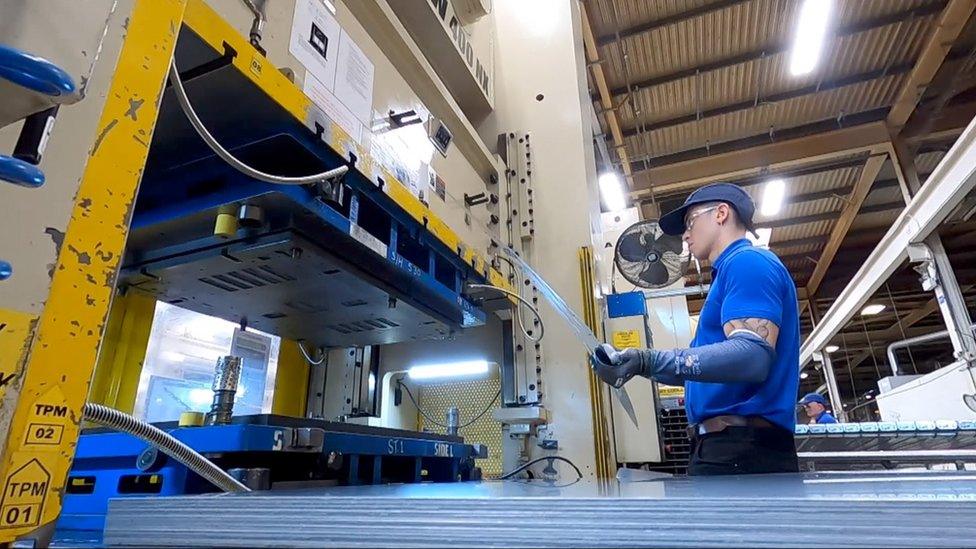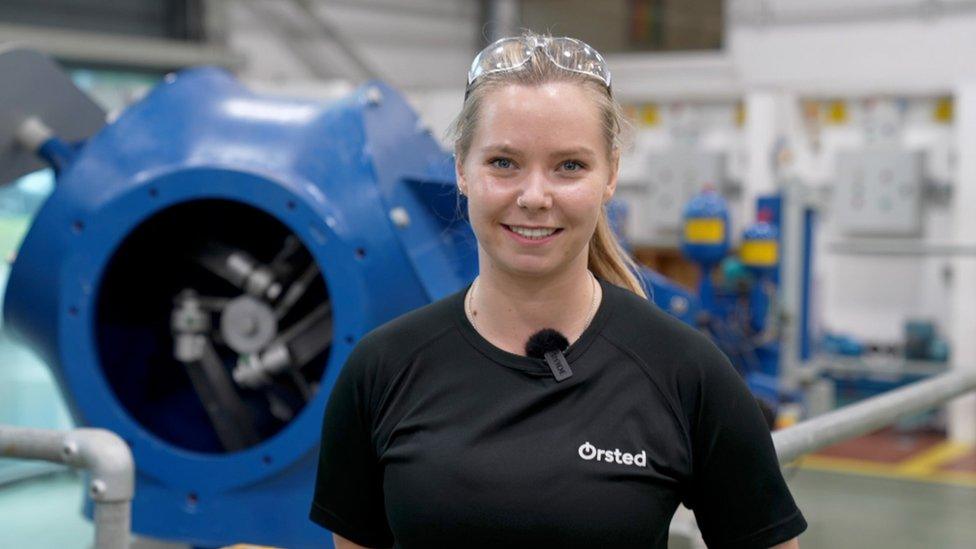Green jobs: The new generation of workers making it work for them
- Published
WATCH: Beth Campbell, 21, is a research assistant at a vertical farm in Scunthorpe
From running huge wind farms out at sea to making new devices to heat our homes, the UK is seeing a rise in interest in so-called green jobs.
What counts as a green job? The simplest answer is that it directly contributes to tackling climate change, although many think it should also cover roles that indirectly support that ambition.
Either way, the UK government wants to create more of them, going from 410,000 now to two million of these jobs by 2030, as part of its plans for an economy with zero fossil fuel emissions.
It's not a plan without risks, but some areas will provide opportunities to many. Here are three jobs in sectors that are growing - and what it's like to do them.
Heating without emissions

Paul McGoogan, 27, works at the Mitsubishi Electric factory
Gas boilers give out emissions that contribute to overheating the planet, and the International Energy Agency think tank says sales need to stop soon if the world is to meet its energy goals.
In Livingston, near Edinburgh, the Mitsubishi Electric factory is making one alternative: air-source heat pumps, which draw warmth from the air to heat your home and water, without releasing any carbon in the process.
Paul McGoogan, 27, started seven years ago on the production line, shaping the metal panels that house the units. He now runs the team.
He says that working in a rising industry doesn't just bring the benefit of job security.
"My girlfriend and I have just bought a new home and the next step for us is to hopefully start a family, so knowing we are doing our bit for a more sustainable future is a big deal for me."
And it's also sustainable for people installing heat pumps: in 2019 there were 900 - by 2028 there are expected to be 15,000.
Low-carbon farming
Visiting 21-year-old Beth Campbell at work in Scunthorpe is like stepping into a world from science fiction.
She works as a research assistant for Jones Food Company, which is the largest vertical farm in Europe. There she checks thousands of basil plants growing on huge trays stacked above each other, all bathed in a gentle purple light and fed a carefully controlled supply of nutrients.

Forests of wind turbines are springing up in the waters around the UK
The water is recycled, the power comes from solar panels on the roof, there's no chemical run-off, no heavy diesel machinery and the crops are sold locally - all to avoid environmental costs.
Moved by the sight of plastic waste on beaches and of harvests failing, Beth signed up for a degree in chemistry, but heard about vertical farming from a David Attenborough documentary and spotted an opportunity not far from her home.
"I applied on a whim and got it, I can't believe it, I was awe when I first came in, the incredible scale of it."
Indoor farming has been around as a concept since the 1920s but never on this scale and with the full range of technologies to make it sustainable. Dozens are being planned across the UK.
"It could revolutionise farming because you're not putting out tonnes and tonnes of carbon just flying things all over the world just for them to go in a bin and rot because they go off before they get there," she says.
Fixing wind turbines at sea
Forests of wind turbines are springing up in the waters around the UK and that's led to a boom in offshore building and maintenance.

Bridie Salmon, 23, is an apprentice technician at a wind firm
It's an industry that directly and indirectly involves 26,000 jobs now - by 2026, that's set to rise to 70,000.
Bridie Salmon, 23, is an apprentice technician for the wind firm Orsted, where she is learning how to service the giant machines, making sure the blades keep turning so they generate zero-carbon power.
It was while seeing the dead corals of the Great Barrier Reef in Australia that she decided to do something about damage to the environment.
Working in an industry that's helping climate change was the top of her list for a career, she tells me, and her enthusiasm is obvious.
We met in a training room at the Grimsby Institute where she was sitting inside a huge hub taken from a turbine, being taught how to run through the electrics to spot faults.
When she qualifies, she will either be staying on a service ship for two weeks at a time to reach the turbines farthest from shore, or doing day trips from her home town of Grimsby for closer sites.
In any event, there will be the challenge of transferring from the ships to the base of the towers, often in rough seas, and long climbs up to get to the inner workings at the top.
Some of the newest turbines stand nearly 200m high - so does she have a head for heights? "Yes," she tells me. "You learn to trust the equipment, that the ropes will hold you, and then the fear disappears."